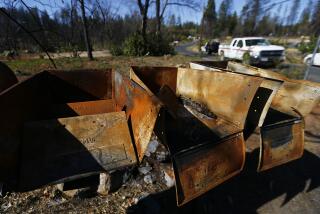State Farm Raises Quake Loss Tally to $2 Billion : Insurance: Firm is fifth major carrier to hike its figure recently. Experts say the total damage is likely to exceed $10 billion.
State Farm Mutual Automobile Insurance Co. on Friday added $500 million to its estimate of losses from the Northridge earthquake, pushing its total to $2 billion and raising the likelihood that industrywide losses from the Jan. 17 catastrophe will exceed $10 billion.
State Farm, the largest property-casualty insurer in California and the United States, is the fifth major carrier to sharply raise its loss total in recent days. State Farm’s losses alone are now more than twice the $960 million in total insured damage caused by the 1989 Loma Prieta temblor, the so-called World Series earthquake that hit the San Francisco Bay Area.
Sean F. Mooney, senior vice president of the Insurance Information Institute, said he expects total insurance damage for the Northridge quake to reach $10 billion to $12 billion. That would still be short of the record $15.5 billion caused by Hurricane Andrew, which devastated Florida and Louisiana in 1992, but Mooney said it raises darker fears about the future of the industry.
“The message that the industry received from Northridge was that we have way underestimated the impact of a major catastrophe,” he said. “The industry was equipped to handle this, but not a $50-billion catastrophe, and now it’s a lot more realistic to envisage a $50-billion one.”
Mooney, an economist, noted that until Hurricane Hugo in 1989, the industry had never recorded a $1-billion catastrophe. “Since then we’ve had six,” he said.
Like its competitors, State Farm said massive amounts of hidden damage are only now coming to light during the rebuilding process.
“The more you do to repair what you thought was damaged, the more damage you uncover,” State Farm spokesman Bill Sirola said. “They go in to redo a wall and they find out that the foundation is cracked and split.”
Allstate Insurance Co., No. 2 in the market, lifted its loss figure to $1.3 billion on Thursday, up $350 million. Earlier, Safeco Insurance Co., 20th Century Insurance Co. and TIG Insurance Co. substantially raised their estimates.
Farmers Insurance Group, third-largest in California, has no plans to update the $1.3-billion loss estimate it released last month, Vice President Jeffrey Beyer said Friday.
State Farm said the number of claims it has received--about 111,000--has not increased much since the company released its $1.5-billion loss estimate in midsummer. However, the severity of the claims has risen dramatically.
Allstate has had a slightly different experience. Spokesmen for the company said it is receiving a steady stream of new claims.
Why would new claims arrive more than eight months after the quake? One reason is that earthquake policies typically carry deductibles of 10% of coverage limits, meaning the first $10,000 or $20,000 or more comes out of the homeowner’s pocket.
Consumers who thought the damage fell below their deductible might put off repairs for some months while trying to line up financing. Only later, when construction began and additional damage was discovered, would they file a claim.
Another factor driving damage estimates upward has been the steadily rising costs of building materials--particularly wood products--and labor.
Mooney said damage to commercial buildings has accounted for only about 5% of the claims so far but about 25% of the losses, in dollar terms.
The industry’s official catastrophe loss figures are prepared by the Property Claims Services unit of American Insurance Services Group. Gary Kerney, director of disaster claims services, said the group is compiling a new survey of 50 to 60 insurers and will release an updated tally next week. Kerney said it will far exceed the current estimate of $7.2 billion, but he declined to speculate beyond that.
More to Read
Inside the business of entertainment
The Wide Shot brings you news, analysis and insights on everything from streaming wars to production — and what it all means for the future.
You may occasionally receive promotional content from the Los Angeles Times.










